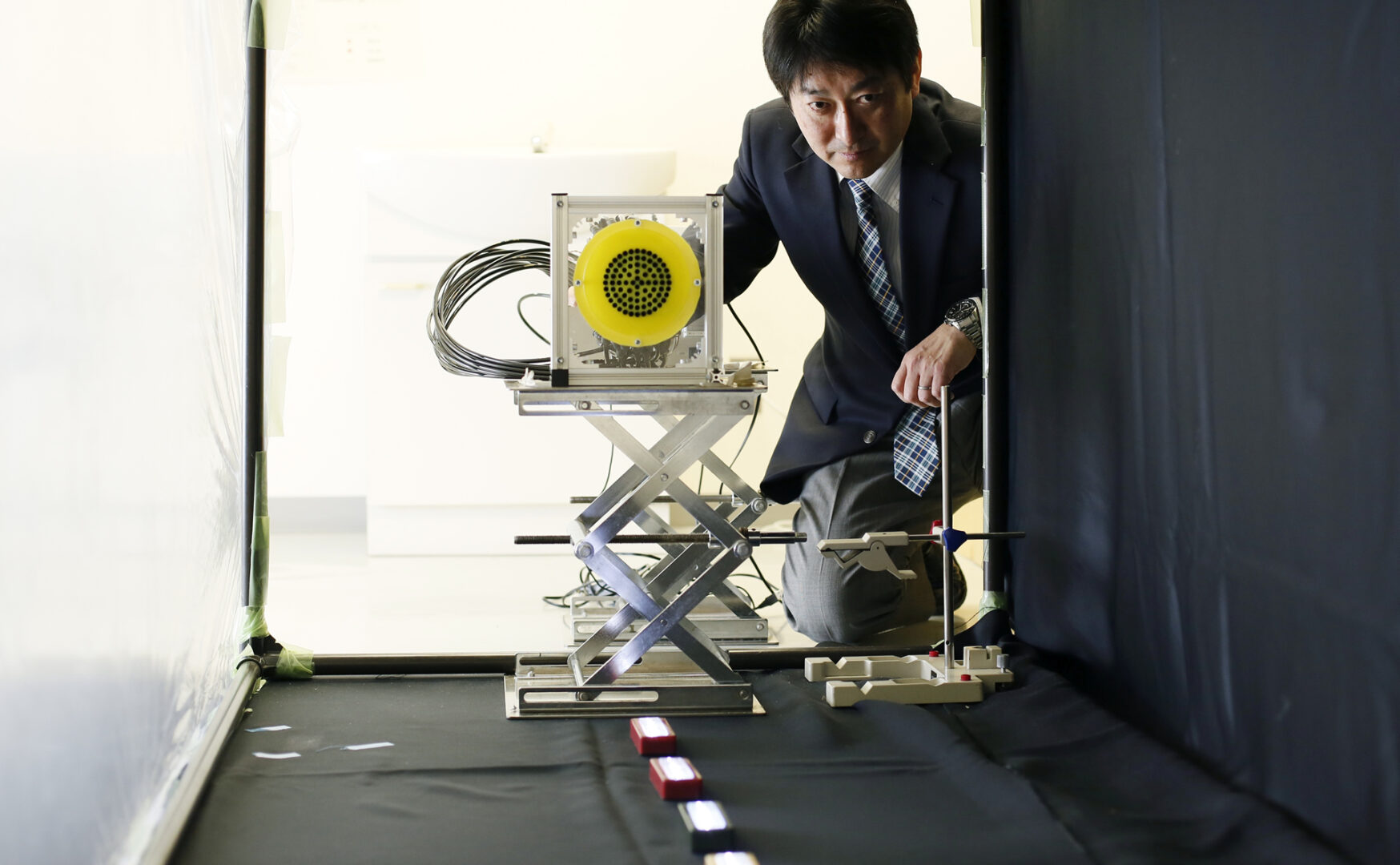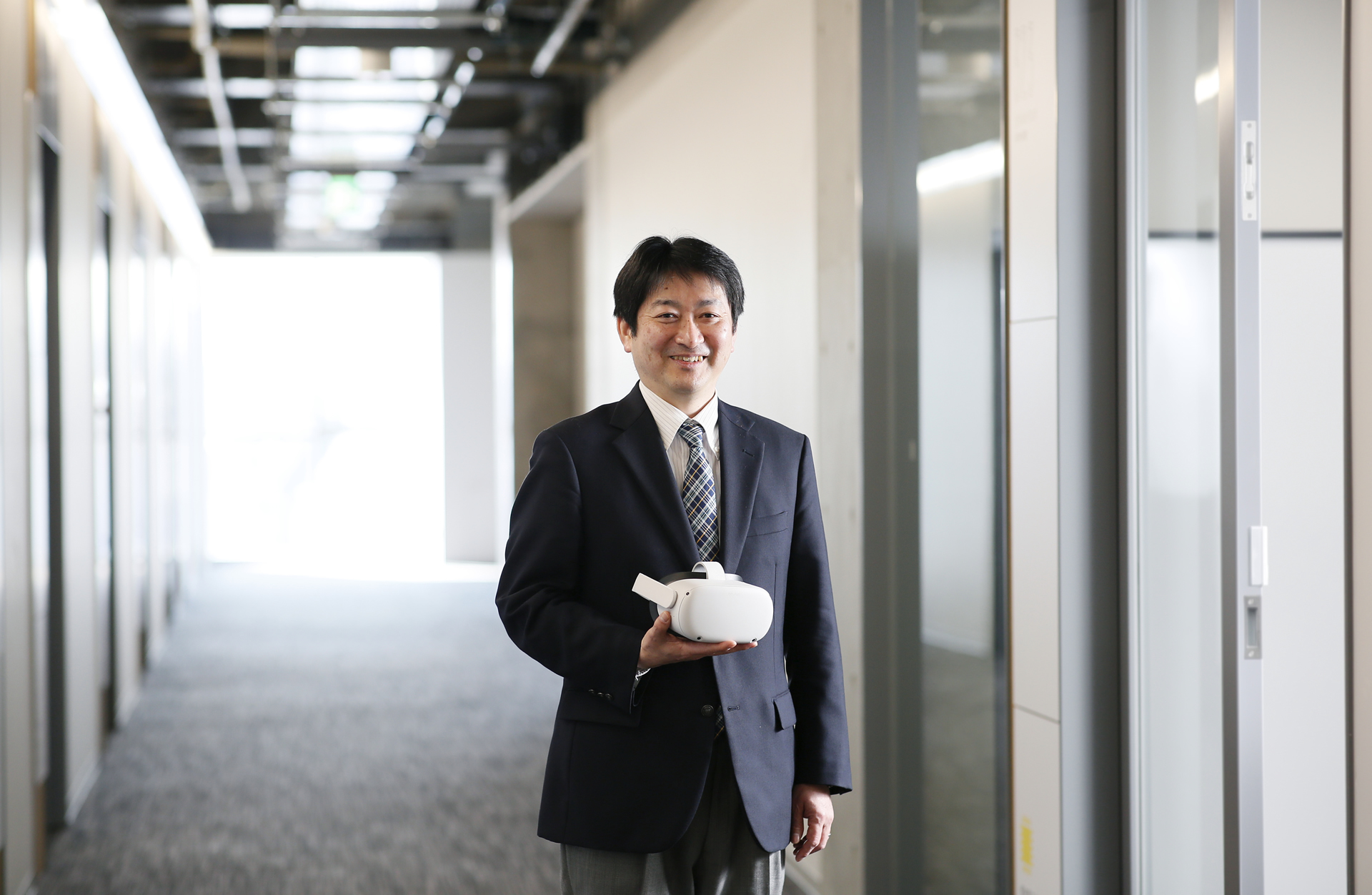If technologies that deliver distant objects are television and telephone, then technologies that make virtual spaces feel real can be called virtual reality (VR). Generally, you can connect to virtual spaces using goggle-type head-mounted displays, which primarily engage your sight and hearing. However, in recent years, 4D theaters have increased, adding movement, scents, wind, and water elements to the visual and auditory experience. Ericsson in Sweden has released a research report anticipating the realization of services linked to sight, hearing, taste, smell, and touch by 2030. Professor Yasuyuki Yanagida discusses these new VR technologies that make virtual worlds feel real.
Controlling Scents to Create the Atmosphere of a Place
 In 1968, Ivan Sutherland in the United States developed the world’s first head-mounted display. Since that invention, various research institutions have begun working on VR, and now VR, which presents audiovisual experiences, has transitioned into industrial fields. In the future, in addition to hardware, both software and content will become increasingly important. Moreover, research in VR focusing on two types of sensory perception—force feedback, which allows us to feel weight and pressure, and tactile feedback, which lets us perceive surface textures like smoothness or roughness—has been progressing from early on. However, even with these advancements, we still can’t fully replicate the feeling of being present in a location—the “atmosphere” of the place. It feels as if we are experiencing VR through a spacesuit. Therefore, I believe that scents will play a crucial role in making people feel truly present, and I am advancing research in VR that appeals to the sense of smell.
In 1968, Ivan Sutherland in the United States developed the world’s first head-mounted display. Since that invention, various research institutions have begun working on VR, and now VR, which presents audiovisual experiences, has transitioned into industrial fields. In the future, in addition to hardware, both software and content will become increasingly important. Moreover, research in VR focusing on two types of sensory perception—force feedback, which allows us to feel weight and pressure, and tactile feedback, which lets us perceive surface textures like smoothness or roughness—has been progressing from early on. However, even with these advancements, we still can’t fully replicate the feeling of being present in a location—the “atmosphere” of the place. It feels as if we are experiencing VR through a spacesuit. Therefore, I believe that scents will play a crucial role in making people feel truly present, and I am advancing research in VR that appeals to the sense of smell.
The challenge with scents lies in the current inability to synthesize them effectively. In the case of vision, humans have three types of cones corresponding to red, blue, and yellow light, and by adjusting the balance of light wavelengths, any color can be represented.
However, for smell, it is said that humans have about 400 types of olfactory receptors, and each receptor can respond to multiple odor molecules. This complexity makes it difficult to create a device that can produce “any scent.” Nevertheless, as research into the mechanisms of olfactory perception is progressing rapidly, it is possible that an efficient method for coding scents will be discovered in the near future, enabling the generation of a wide range of odors.
As a “VR specialist,” I am not focused on the synthesis of scents but on “how to control scents temporally and spatially.” There are various methods for presenting scents. For example, attaching a scent generator to a head-mounted display is a classic approach. Another method involves attractions in theme parks that synchronize scents with visuals, using large-scale equipment to introduce and then quickly withdraw the scent. In contrast, I am exploring how to efficiently deliver a minimal amount of scent directly to the nose. My research aims to present scents briefly and locally without requiring the user to wear a device or rely on large equipment. One of the solutions I conceived is using an “air cannon.” Many people have seen air cannons used in science classes, where a puff of air is propelled forcefully. I began researching how this could be utilized to present scents indoors to a specific person.
To provide experiences from different worlds, overcoming the constraints of time and place.
 I believe there are various ways to utilize VR with scents. For example, it could be used as an advertising tool. Think of the enticing aroma wafting from an eel restaurant, which acts as a form of advertisement by drawing in passersby with the smell of grilled eel. We could do something similar on an individual basis. In shopping malls, sensors could identify the attributes of people passing by and subtly introduce corresponding scents. This kind of application might not be too far off in the future.
I believe there are various ways to utilize VR with scents. For example, it could be used as an advertising tool. Think of the enticing aroma wafting from an eel restaurant, which acts as a form of advertisement by drawing in passersby with the smell of grilled eel. We could do something similar on an individual basis. In shopping malls, sensors could identify the attributes of people passing by and subtly introduce corresponding scents. This kind of application might not be too far off in the future.
There are also attempts to add scent generators to smartphones. While this technology may not become widespread immediately, it will likely see more use as the know-how accumulates and development progresses.
Expanding VR to the five senses is one of my major goals. I aim to advance research by examining the interplay between “sight,” “hearing,” “touch,” “smell,” and “taste.” As urban dwellers, we are inundated with information via electronic media, leading to fewer tangible experiences. Although VR is an electronic medium, my goal is to develop technologies that offer immersive experiences beyond just visual and auditory stimuli, free from the constraints of time and place.
Interview Date: April 14, 2021

